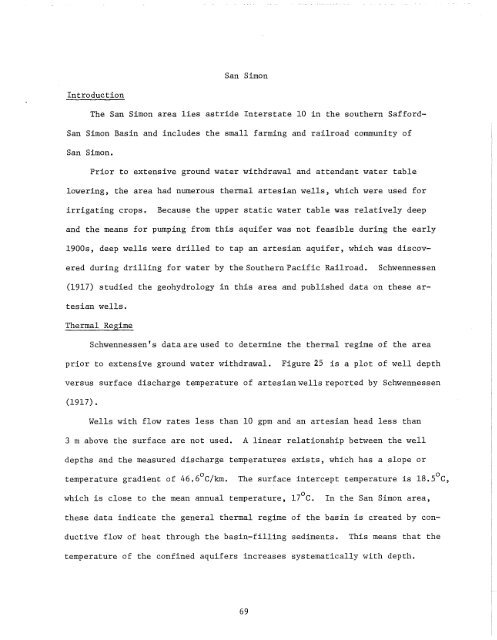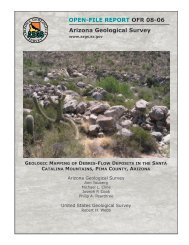geothermal resource potential of the safford-san simon basin, arizona
geothermal resource potential of the safford-san simon basin, arizona
geothermal resource potential of the safford-san simon basin, arizona
Create successful ePaper yourself
Turn your PDF publications into a flip-book with our unique Google optimized e-Paper software.
San Simon<br />
Introduction<br />
The San Simon area lies astride Interstate 10 in <strong>the</strong> sou<strong>the</strong>rn Safford-<br />
San Simon Basin and includes <strong>the</strong> small farming and railroad community <strong>of</strong><br />
San Simon.<br />
Prior to extensive ground water withdrawal and attendant water table<br />
lowering, <strong>the</strong> area had numerous <strong>the</strong>rmal artesian wells, which were used for<br />
irrigating crops.<br />
Because <strong>the</strong> upper static water table was relatively deep<br />
and <strong>the</strong> means for pumping from this aquifer was not feasible during <strong>the</strong> early<br />
1900s, deep wells were drilled to tap an artesian aquifer, which was discovered<br />
during drilling for water by <strong>the</strong> Sou<strong>the</strong>rn Pacific Railroad.<br />
Schwennessen<br />
(1917) studied <strong>the</strong> geohydrology in this area and published data on <strong>the</strong>se artesian<br />
wells.<br />
Thermal Regime<br />
Schwennessen's data are used to determine <strong>the</strong> <strong>the</strong>rmal regime <strong>of</strong> <strong>the</strong> area<br />
prior to extensive ground water withdrawal. Figure 25 is a plot <strong>of</strong> well depth<br />
versus surface discharge temperature <strong>of</strong> artesian wells reported by Schwennessen<br />
(1917).<br />
Wells with flow rates less than 10 gpm and an artesian head less than<br />
3 m above <strong>the</strong> surface are not used. A linear relationship between <strong>the</strong> well<br />
depths and <strong>the</strong> measured discharge temperatures exists, which has a slope or<br />
temperature gradient <strong>of</strong> 46.6°C/km.<br />
o<br />
The surface intercept temperature is 18.5 C,<br />
which is close to <strong>the</strong> mean annual temperature, l7 o C.<br />
In <strong>the</strong> San Simon area,<br />
<strong>the</strong>se data indicate <strong>the</strong> general <strong>the</strong>rmal regime <strong>of</strong> <strong>the</strong> <strong>basin</strong> is created by conductive<br />
flow <strong>of</strong> heat through <strong>the</strong> <strong>basin</strong>-filling sediments.<br />
This means that <strong>the</strong><br />
temperature <strong>of</strong> <strong>the</strong> confined aquifers increases systematically with depth.<br />
69

















